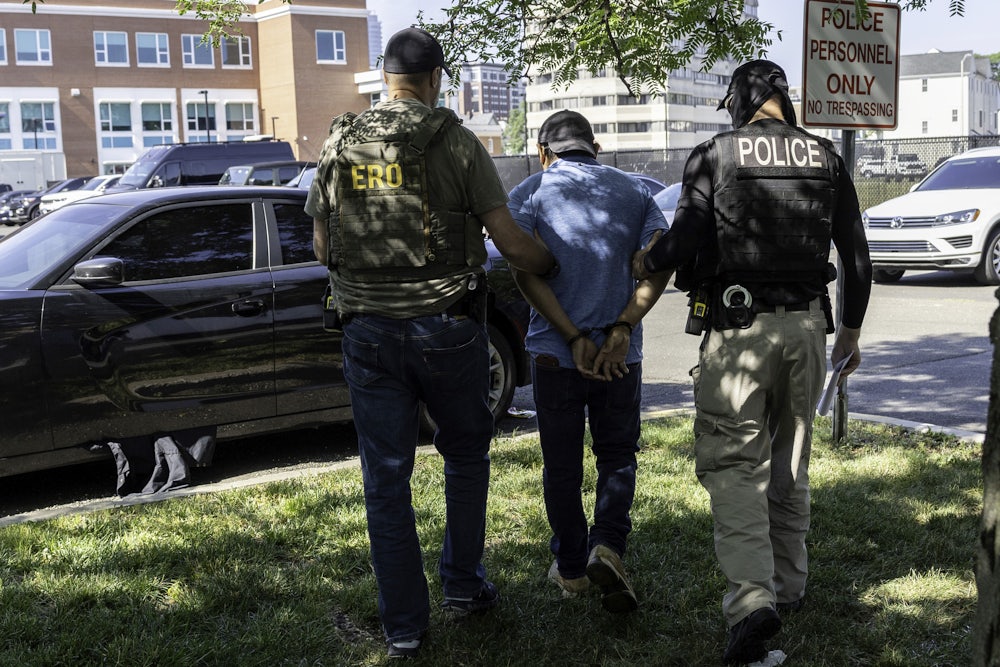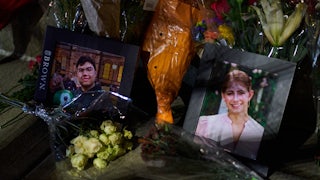A recent report from ProPublica documents the detentions of some 170 American citizens by Immigration and Customs Enforcement during its anti-immigration operations. But the implications of the report go considerably further, suggesting an agency completely out of control and flouting the Fourth Amendment at every turn.
The report is a harrowing demonstration of ICE overreach. It puts the lie to the declaration of the Department of Homeland Security spokesperson that “we don’t arrest U.S. citizens for immigration enforcement.” The facts on the ground tell a very different tale.
ProPublica’s report chronicled a series of ICE arrests that would be hard to believe if they weren’t backed by official complaints and eyewitnesses. In one, masked agents pointed a gun at, pepper-sprayed, and punched a young man whose only offense was filming them as they searched for his relative. In another, they tackled a 79-year-old car-wash owner, pressing their knees into his neck and back. The man, who had just undergone heart surgery, was left with broken ribs and was denied medical attention for 12 hours. In a third case, agents handcuffed a woman on her way to work and held her for more than two days—without any contact with the outside world.
All Americans, even those for whom immigrants are instinctively “other,” should be disgusted by these abominations, which make clear that there is no foolproof protection for anyone, Americans included, from ICE’s rabid tactics.
The report documents two categories of concern. As ProPublica notes, about 130 of the total number were arrested for allegedly assaulting officers. Many of these allegedly were overblown: ProPublica notes that they produced a “handful” of guilty pleas to misdemeanors. At least 50 of those cases were tossed, or charges were never filed.
So they give rise to questions about whether ICE is abusing its power to arrest law-abiding protesters, like the man who was pepper-sprayed for the “crime” of videoing agents. Protesters can be raucous, but raucousness is not a crime.
It is the other category of detained Americans, at least 50, that presents a graver indictment of ICE. Consider that nothing sets apart these relatively few American victims of ICE from the tens of thousands of people the agents scrutinize. Nor do the agents know their nationality when they confront them. So what we’re seeing in the ProPublica report is very likely ICE’s general M.O. And a series of lawsuits on behalf of noncitizens alleges exactly that.
When agents encounter strangers, the Fourth Amendment imposes three core limitations:
1. If, and only if, agents have particularized suspicion that a person may be guilty of a crime, they can stop the person (make a “Terry stop”) and pose a brief series of questions to dispel or confirm their suspicions. This is the basic dividing line that border czar Tom Homan and others in the administration say the agents are following in nearly every case.
2. If, and only if, agents have developed probable cause that a person is guilty of a crime, they can arrest them—restrain their physical movements. That includes, of course, Americans or anyone else who assaults law enforcement.
3. At all times, including during arrests, agents may not employ force that is unreasonable under the circumstances.
These three guideposts mark the difference between a democracy and a police state. And yet, in case after case, ICE agents are blowing through those guardrails.
The three Kafkaesque tales above all revolve around multiple constitutional violations. Lacking particularized suspicion of an immigration offense, the ICE agents were prohibited from even a brief detention. Their actions plainly constitute arrests without probable cause. And they proceeded to apply patently unreasonable force.
We’ve seen similar arrests and unreasonable force wherever ICE has operated. The abuses in the ProPublica report are only a small subset. It’s been a core reason that a series of courts—from Chicago to Portland to Los Angeles—have come down hard on the agency.
Judge Sara Ellis in Chicago found that ICE agents repeatedly violated reporters’ and activists’ Fourth Amendment rights. She refused the government’s request to limit relief to one immigration facility, concluding that the violations were widespread. “If I felt secure that this was only happening in Broadview,” Ellis said, “I’d be happy to limit it, but I don’t believe that is the case.”
Would that the Supreme Court shared her justifiably jaundiced view. In the court’s recent decision to permit agents to stop people based on their skin color, language, and the kind of work they were seeking, Justice Brett Kavanaugh parroted the administration’s line. He wrote, “If the officers learn that the individual they stopped is a U.S. citizen or otherwise lawfully in the United States, they promptly let the individual go.”
In fact, every week brings new videos of federal agents ignoring, detaining, tackling, and pepper-spraying their prey—deploying force in situations where even local police, bound by far stricter accountability, would hesitate to make an arrest. The pattern suggests not isolated mistakes but a systemic culture of impunity and contempt for constitutional safeguards. Watching Gregory Bovino, the head agent in charge of ICE’s Chicago operation, strut contemptuously into Judge Ellis’s courtroom like Colonel Jessup (Jack Nicholson) in A Few Good Men left little confidence that senior ICE officials are instilling in their agents any ethos of constitutional compliance.
It’s tempting to see these cases as tragic anomalies. They are not. They are the predictable consequence of a political project that conflates law enforcement with warfare and citizens with suspects. Each time a citizen is wrongly detained or beaten by federal agents, the injury extends beyond the individual: It erodes the shared understanding that government power must answer to the Constitution.
What the ProPublica investigation reveals is not simply a rogue agency but a government willing to tolerate—and at times encourage—lawlessness in its name. In community after community, ICE has created zones of fear where both citizens and noncitizens tread carefully, knowing that a routine errand or encounter could end in detention.
The same authoritarian reflex that animates the president’s contempt for judges and journalists is now operating in street-level enforcement, where ordinary Americans are discovering that their citizenship is no shield against state violence.
The lesson of abusive, unconstitutional treatment of American citizens is thus not limited to immigration. It is a warning about the corrosion of constitutional culture itself. A government that flouts the Fourth Amendment and then lies about it to courts and the people has already crossed a moral and legal frontier. The question is whether the country will fight back before the border between law and lawlessness disappears altogether.






